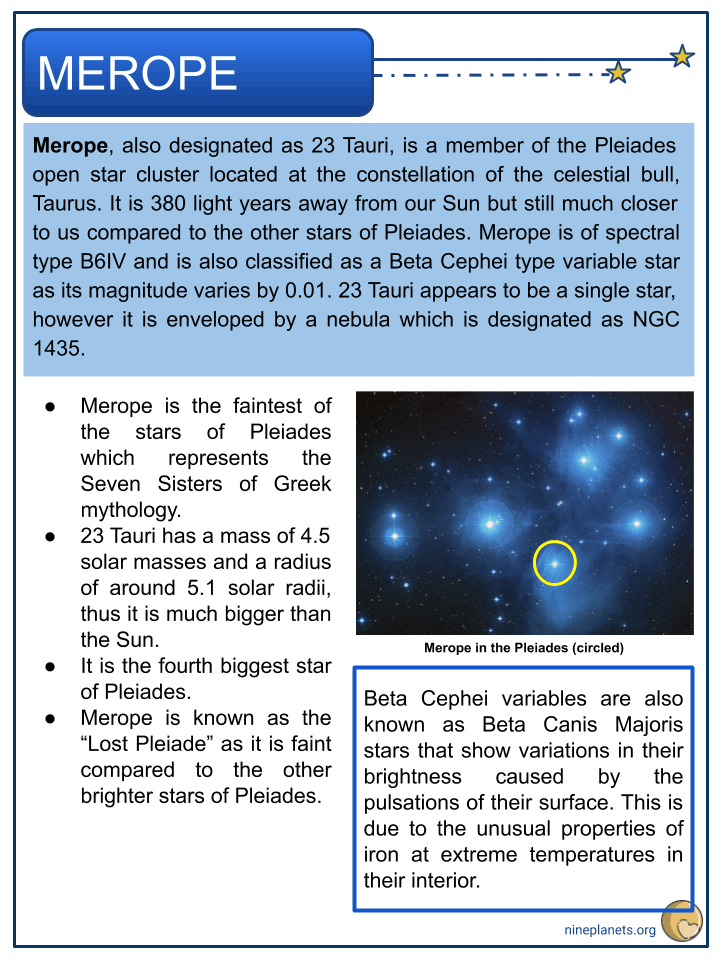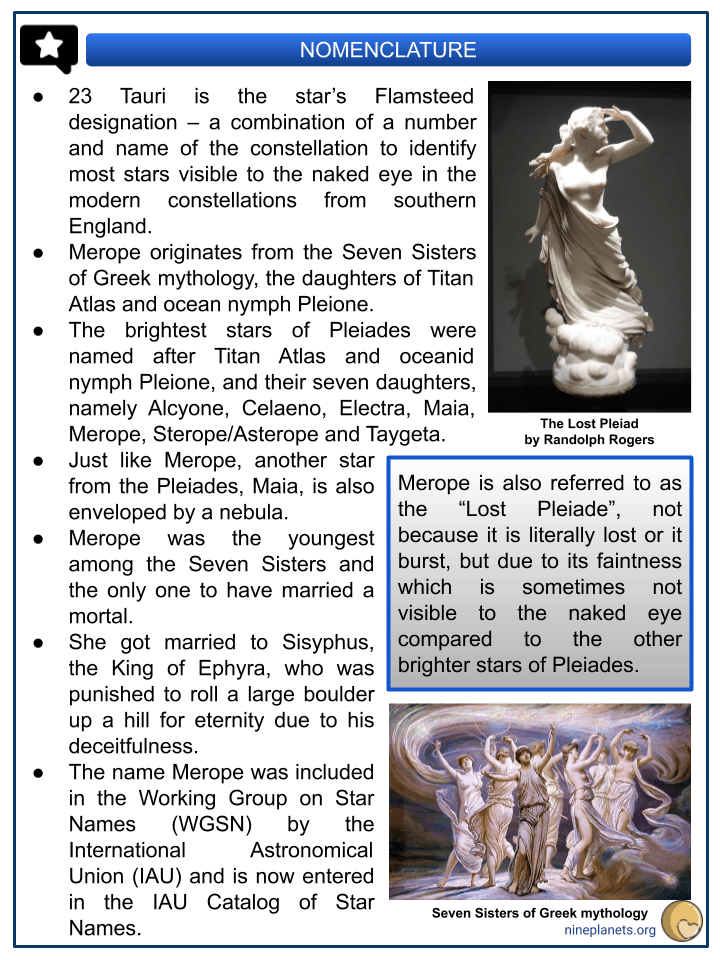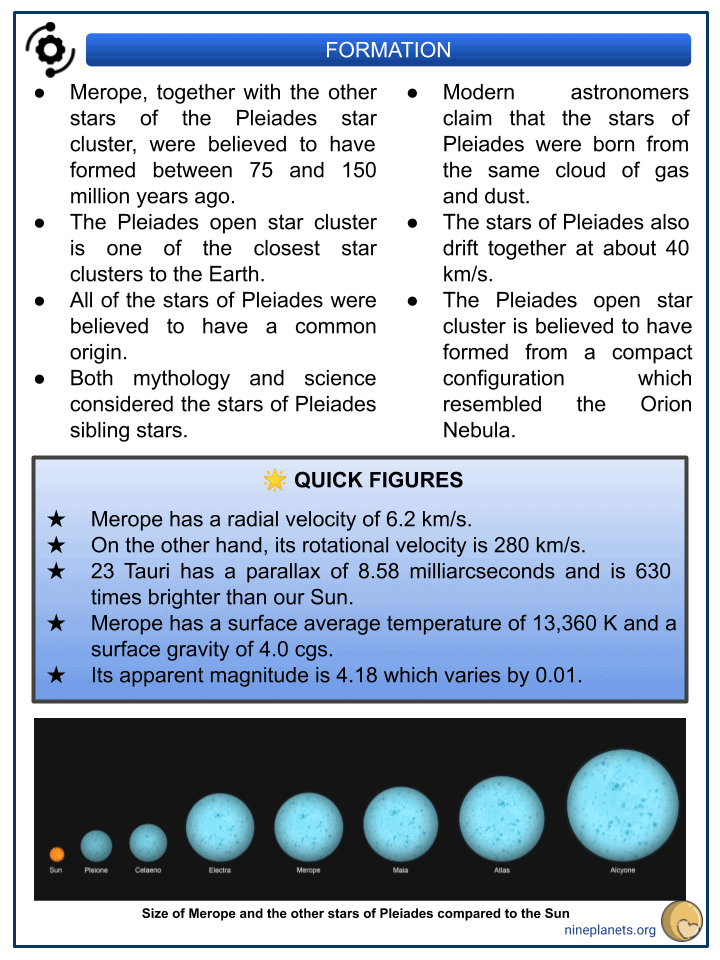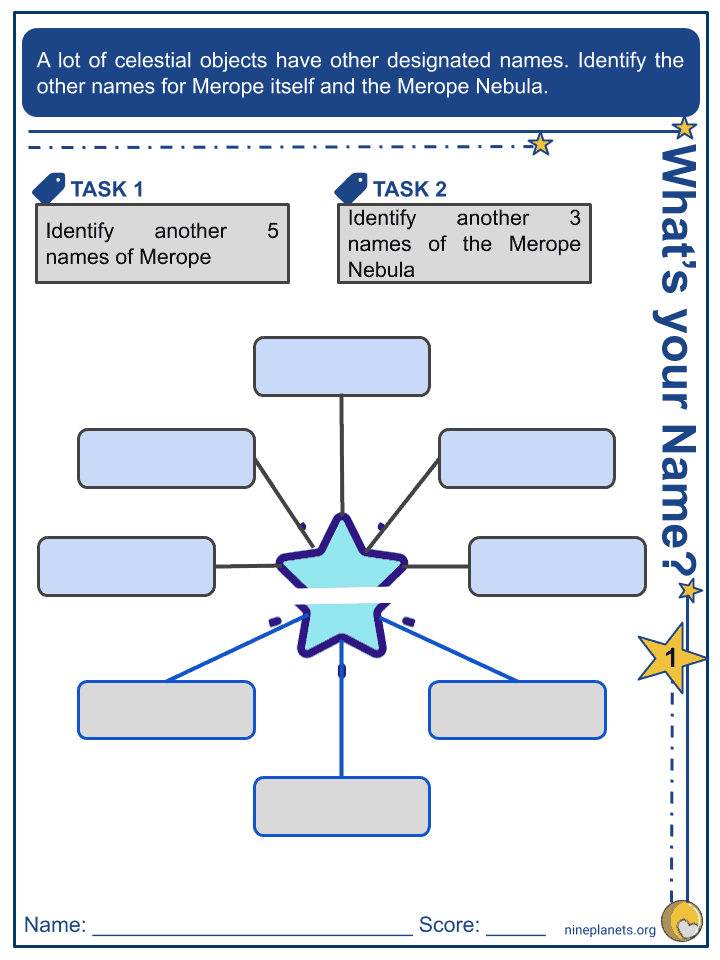Download Merope Worksheets
Click the button below to get instant access to these premium worksheets for use in the classroom or at a home.

This worksheet can be edited by Premium members using the free Google Slides online software. Click the Edit button above to get started.
Download free sample
Not ready to purchase a subscription yet? Click here to download a FREE sample of this worksheet pack.
Resource Examples
Click any of the example images below to view a larger version.




Key Facts & Information
- Merope, also designated as 23 Tauri, is a member of the Pleiades open star cluster located at the constellation of the celestial bull, Taurus. It is 380 light years away from our Sun but still much closer to us compared to the other stars of Pleiades. Merope is of spectral type B6IV and is also classified as a Beta Cephei type variable star as its magnitude varies by 0.01. 23 Tauri appears to be a single star, however it is enveloped by a nebula which is designated as NGC 1435.
- Merope is the faintest of the stars of Pleiades which represents the Seven Sisters of Greek mythology.
- 23 Tauri has a mass of 4.5 solar masses and a radius of around 5.1 solar radii, thus it is much bigger than the Sun.
- It is the fourth biggest star of Pleiades.
- Merope is known as the “Lost Pleiade” as it is faint compared to the other brighter stars of Pleiades.
- Beta Cephei variables are also known as Beta Canis Majoris stars that show variations in their brightness caused by the pulsations of their surface. This is due to the unusual properties of iron at extreme temperatures in their interior.
Nomenclature
- 23 Tauri is the star’s Flamsteed designation – a combination of a number and name of the constellation to identify most stars visible to the naked eye in the modern constellations from southern England.
- Merope originates from the Seven Sisters of Greek mythology, the daughters of Titan Atlas and ocean nymph Pleione.
- The brightest stars of Pleiades were named after Titan Atlas and oceanid nymph Pleione, and their seven daughters, namely Alcyone, Celaeno, Electra, Maia, Merope, Sterope/Asterope and Taygeta.
- Just like Merope, another star from the Pleiades, Maia, is also enveloped by a nebula.
- Merope was the youngest among the Seven Sisters and the only one to have married a mortal.
- She got married to Sisyphus, the King of Ephyra, who was punished to roll a large boulder up a hill for eternity due to his deceitfulness.
- The name Merope was included in the Working Group on Star Names (WGSN) by the International Astronomical Union (IAU) and is now entered in the IAU Catalog of Star Names.
- Merope is also referred to as the “Lost Pleiade”, not because it is literally lost or it burst, but due to its faintness which is sometimes not visible to the naked eye compared to the other brighter stars of Pleiades.
Formation
- Merope, together with the other stars of the Pleiades star cluster, were believed to have formed between 75 and 150 million years ago.
- The Pleiades open star cluster is one of the closest star clusters to the Earth.
- All of the stars of Pleiades were believed to have a common origin.
- Both mythology and science considered the stars of Pleiades sibling stars.
- Modern astronomers claim that the stars of Pleiades were born from the same cloud of gas and dust.
- The stars of Pleiades also drift together at about 40 km/s.
- The Pleiades open star cluster is believed to have formed from a compact configuration which resembled the Orion Nebula.
Quick Figures
- Merope has a radial velocity of 6.2 km/s.
- On the other hand, its rotational velocity is 280 km/s.
- 23 Tauri has a parallax of 8.58 milliarcseconds and is 630 times brighter than our Sun.
- Merope has a surface average temperature of 13,360 K and a surface gravity of 4.0 cgs.
- Its apparent magnitude is 4.18 which varies by 0.01.
Taurus
- Merope is located at the constellation of the celestial bull, Taurus.
- Taurus is one of the 48 Greek constellations which were first listed in the 2nd century by the Greco-Roman astronomer Ptolemy.
- The constellation of Taurus is one of the largest in the night’s sky, and so one of the most prominent northern constellations with an area of 797 square degrees.
- Aside from the Pleiades star cluster, Taurus is also home to interesting celestial objects such as the stars Aldebaran and Elnath, nebulosity named Crab nebula and Crystal Ball nebula, the reflection nebula NGC 1555, also known as Hind’s Variable Nebula, merging galaxies NGC 1409 and NGC 1647, supernova remnant Messier 1, and a lot more open clusters including Hyades.
- These celestial objects are best observed and studied in the month of January.
Pleiades
- The Pleiades is one of the closest star clusters to the Earth and is best observed from October to April.
- The Pleiades is very bright but we cannot see it in the months of May and June as the Sun blocks our view during that period.
- A lot of the stars of the Pleiades star cluster shine much more brightly than our Sun.
- The Pleiades star cluster is mostly dominated by very hot blue and luminous stars and the majority of the brightest and hottest stars of Pleiades are of spectral class B.
- In Greek mythology, the Seven Sisters were turned into stars by Zeus as the huntsman, Orion, pursued them. Their father, Atlas, was condemned to carry the heavens on his shoulder.
- The star cluster Pleiades can be found in the night’s sky by drawing an imaginary line using Orion’s belt: Alnitak, Alnilam and Mintaka.
- Pass through the bow of the huntsman and you find the brightest star of Taurus, Aldebaran. Past Aldebaran is the Pleiades star cluster.
- Merope lies in the lower part of the Pleiades.
Merope Nebula
- The star Merope is enveloped by a nebulosity which is cataloged as NGC 1535.
- The nebula is named after Merope and is also sometimes referred to as the Tempel’s Nebula, in honour of the German astronomer who discovered it in 1859, Wilhelm Tempel, and described it as a faint nebula about the size of the moon in his New General Catalogue.
- The diffuse reflection nebula around Merope is the brightest, wherein the apparent magnitude is 13, while the rest of the nebula is fainter than magnitude 16.
- The Merope Nebula is also part of a larger nebulosity that envelops the Pleiades star cluster.
- The larger nebula is a huge interstellar dust cloud through which the stars of Pleiades are passing through.
- This cloud is actually dispersed by the passing of the stars.
- The Merope Nebula is an example of a cold, dense, very small-scale condensation of the interstellar medium.
- The nebula appears to have a roughly pentagonal shape with a bright knot situated nearest to Merope.
- NGC 1435 appears blue in photographs due to the fine carbon dust spread throughout the cloud.
- IC 349 is a bright knot within the nebula and is located around 36” northwest of Merope.
- IC 349 is almost half an arcminute wide.
- The knot was discovered by the American astronomer Edward Emerson Barnard in November 1890, thus IC 349 is also known as the Barnard’s Merope Nebula.
- Further analysis of the space motion of the nebula indicates that it does not share the velocity and the direction of the stars of Pleiades.
- It may also have originated in the Taurus Molecular cloud complex as it shares the velocity of the molecular gas in this nebula.
- Merope also has other designated names: 2MASX J04141578-1244216, IRAS 04119-1251, PN G 206.4-40.5, PK 206-40.1, dML87 112, UITBOC 627, VERA J0414-1244
- The Merope Nebula is around 440 light years away from us.
- Its apparent magnitude is 13 while its absolute magnitude is 8.
- It has a radius of 2 light years and apparent dimensions of 30’.
- Merope will continue to exist for many millions of years. However, a lot of computer simulations suggest that the Pleiades star cluster will continue to exist for another 250 million years and will disperse due to the gravitational interactions with its galactic neighbourhood.
Did You Know?
- The Taurus constellation and the Pleiades star cluster are visible enough and were known to the ancient world.
- The Pleiades star cluster is also known as Messier 45.
- In Greek mythology, the stars of Hyades are daughters of Titan Atlas and the oceanid nymph Aethra, making them half-sisters of the stars of Pleiades.
- J.K. Rowling used many star names for the characters of the Harry Potter series. Merope Riddle is the name of the mother of Lord Voldemort.
- The Chinese know Merope as the Fifth Star of the Hairy Head – which is an asterism which consists of the Pleiades stars Asterope, Alcyone, Atlas, Electra, Maia, Merope and Taygeta
- The Nebra Sky Disk, which is a Bronze Age artefact dating to 1600 BC, uncovered in Germany, contains one of the believed earliest depictions of the Pleiades open star cluster and its stars.
- A lot of famous and ancient texts mention the Pleiades, such as Homer’s Iliad and Odyssey, Hesiod’s Works and Days, the Bible, the ancient Egyptian Calendar of Lucky and Unlucky Days, and also the Japanese Kojiki – An Account of Ancient Matters which is the 8th-century chronicle of myths, oral traditions and legends
- The Pleiades stars are mentioned in the Kojiki as the Mutsuraboshi which means “six stars”.
- In Japan, the Pleiades star cluster is known as “Subaru”, meaning “coming together”.
- A car manufacturer used it as their logo and incorporated six stars that represent the five companies that merged into one.
- Just like the other stellar objects, Merope also has other stellar designation names aside from 23 Tauri, which are: V971 Tauri, HR 1156, BD 23° 522, HD 23480, HIP 17608, SAO 76172, GC 4512, and CCDM J03463+2357A.